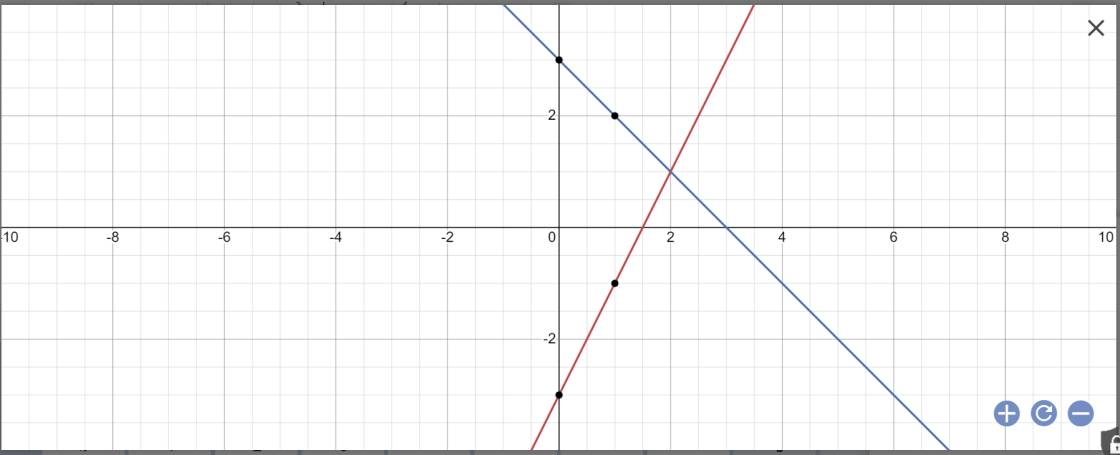Hãy nhập câu hỏi của bạn vào đây, nếu là tài khoản VIP, bạn sẽ được ưu tiên trả lời.

Gọi \(A\left(x;0\right)\) là giao điểm của (d1) và (d2) trên trục Ox
\(\Rightarrow\)\(A\left(x;0\right)\) là nghiệm của hệ\(\left\{{}\begin{matrix}y=2mx+m+1\left(d_1\right)\\y=\left(m-1\right)x+3\left(d_2\right)\end{matrix}\right.\)
\(\Rightarrow\left\{{}\begin{matrix}0=2mx+m+1\left(d_1\right)\\0=\left(m-1\right)x+3\left(d_2\right)\end{matrix}\right.\)
Dễ thấy tại \(\left(d_2\right)\) thì \(m\ne1\) (vì nếu m=0 thì khi đó 0=3 vô lý)
Hệ\(\Leftrightarrow\left\{{}\begin{matrix}0=2mx+m+1\\x=\dfrac{3}{1-m}\end{matrix}\right.\)\(\Rightarrow2m.\dfrac{3}{1-m}+m+1=0\)
\(\Leftrightarrow-m^2+6m+1=0\)
\(\Leftrightarrow\left[{}\begin{matrix}m=3+\sqrt{10}\\m=3-\sqrt{10}\end{matrix}\right.\)(thỏa)
Vậy...

a, PTHDGD: \(x+1=2x+5\Leftrightarrow x=-4\Leftrightarrow y=-3\Leftrightarrow A\left(-4;-3\right)\)
Vậy \(A\left(-4;-3\right)\) là giao 2 đths
b, PTHDGD: \(5-3x=3-x\Leftrightarrow x=1\Leftrightarrow y=2\Leftrightarrow B\left(1;2\right)\)
Vậy \(B\left(1;2\right)\) là giao 2 đths
c, PTHDGD: \(2x-1=-2x+3\Leftrightarrow x=1\Leftrightarrow y=1\Leftrightarrow C\left(1;1\right)\)
Vậy \(C\left(1;1\right)\) là giao 2 đths
d, PTHDGD: \(x+2=3x-4\Leftrightarrow x=3\Leftrightarrow y=5\Leftrightarrow D\left(3;5\right)\)
Vậy \(D\left(3;5\right)\) là giao 2 đths

\(b,\) PT hoành độ giao điểm: \(3x+2=x-2\Leftrightarrow x=-2\Leftrightarrow y=-4\Leftrightarrow A\left(-2;-4\right)\)
Vậy \(A\left(-2;-4\right)\) là tọa độ giao điểm

a: Tọa độ giao điểm là:
\(\left\{{}\begin{matrix}\dfrac{1}{3}x+m+\dfrac{1}{3}=2x-6m+5\\y=\dfrac{1}{3}x+m+\dfrac{1}{3}\end{matrix}\right.\Leftrightarrow\left\{{}\begin{matrix}-\dfrac{5}{3}x=-7m+5\\y=\dfrac{1}{3}x+m+\dfrac{1}{3}\end{matrix}\right.\)
\(\Leftrightarrow\left\{{}\begin{matrix}x=\dfrac{21}{5}m-3\\y=\dfrac{1}{3}\left(\dfrac{21}{5}m-3\right)+m+\dfrac{1}{3}=\dfrac{7}{5}m-1+m+\dfrac{1}{3}=\dfrac{12}{5}m-\dfrac{2}{3}\end{matrix}\right.\)
b: Theo đề, ta có: \(\dfrac{12}{5}m-\dfrac{2}{3}=9\cdot\left(\dfrac{21}{5}m-3\right)^2\)
Đến đây bạn chỉ cần giải phương trình bậc hai ra thôi

a )
Đồ thị parapol P đi qua điểm M khi a là nghiệm của phương trình :
\(2=a.2^2\)
\(\Leftrightarrow4a=2\)
\(\Leftrightarrow a=\dfrac{1}{2}\)

a, bạn tự vẽ nhé
b, Hoành độ giao điểm thỏa mãn phương trình
\(2x-3=-3x+7\Leftrightarrow5x=10\Leftrightarrow x=2\)
Thay vào ptđt d1 ta được : \(y=4-3=1\)
Vậy d1 cắt d2 tại A(2;1)

a: 
b: Phương trình hoành độ giao điểm là:
2x-3=3-x
=>3x=6
=>x=6/3=2
Thay x=2 vào y=3-x, ta được:
\(y=3-2=1\)
\(a,\text{PT hoành độ giao điểm: }3x+5=-2x+7\\ \Leftrightarrow5x=2\Leftrightarrow x=\dfrac{2}{5}\Leftrightarrow y=\dfrac{31}{5}\Leftrightarrow A\left(\dfrac{2}{5};\dfrac{31}{5}\right)\\ \text{Vậy }A\left(\dfrac{2}{5};\dfrac{31}{5}\right)\text{ là giao 2 đths}\)